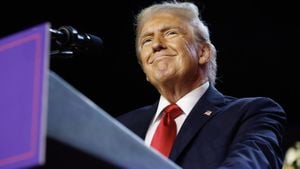Formula 1 has made headlines recently with its announcement confirming General Motors' entry onto the grid for the 2026 season, branding it as Cadillac. This significant development marks the first time an American automaker will compete as part of the elite racing series, which has witnessed growing interest and expansion over the years, particularly from U.S.-based audiences and manufacturers.
The deal between Formula 1 and General Motors (GM) came after years of attempts by Michael Andretti, son of the legendary driver Mario Andretti, to secure entry under the Andretti Global name. The original bid faced stiff resistance from F1 teams, who expressed skepticism about the added value of introducing more teams without significantly enhancing competition on the grid.
Initially, the sport had ten teams, unchanged since 2017. But recently, it undertook extensive discussions with GM and its strategic partner, TWG Global, following months of commercial assessments about the viability of such an entry. F1 remarked, "General Motors has achieved operational milestones and made clear their commitment to brand the eleventh team GM/Cadillac," which indicates their serious investment and planning.
The shift away from the Andretti name was strategic, reflecting the F1 teams’ lukewarm reception to the original Andretti-led bid. Resistance stemmed from Michael Andretti's criticism of F1 as "greedy" for blocking his entry, which did not sit well within F1’s established culture. His stepping down from daily operational responsibilities has potentially opened the door for GM’s renewed bid to flourish under the Cadillac name, paving the way for Andretti, now reportedly serving as a director on the new team's board, to contribute without bearing the brunt of initial opposition.
Mark Reuss, President of General Motors, praised the opportunity to race alongside automotive giants, stating, "It’s an honor for General Motors and Cadillac to join the world’s premier racing series, and we’re committed to competing with passion and integrity." This sentiment highlights GM's intent to leverage this racing venture as both promotion for its brand and as a stage to showcase its engineering prowess. Cadillac has also indicated plans to have its own engines ready for competition by the end of the decade, initially running on Ferrari engines for its first two seasons before progressing to their independently manufactured units.
This Cadillac team aims to engage American fans through its rich heritage and innovation. With F1's popularity booming stateside, the addition of Cadillac brings renewed excitement and potentially lures budding American talent to the sport. Indeed, speculation has already begun around which American drivers may pilot the Cadillac F1 cars. Names like Colton Herta, Alexander Rossi, and Josef Newgarden are being circuited as favorable candidates, as the team must capitalize on the opportunity to field local talent and cultivate American interest.
While Cadillac will be the 11th team on the F1 grid, it will not be the only American team present. The Haas F1 team has been operational since 2016, albeit without fielding an American driver. This gives Cadillac the chance to reinvigorate the narrative surrounding American drivers and brands within the sport. The fact today’s entry is not from the Haas operation demonstrates F1’s diversification, enhancing both competition and interest among fans.
Brought to life under the guidance of the newly appointed CEOs Dan Towriss and Mark Walter, the Cadillac F1 team seeks to build on the potential for American innovation and culture within the amateur racing domain. With operations to be conducted across multiple sites, including Silverstone, Indiana, North Carolina, and Michigan, the team is well-placed to embrace both research, development, and practical execution.
Greg Maffei, the outgoing CEO of Liberty Media, pointed out the importance of American brands like GM supporting the sport's growth, especially as it looks to expand its audience footprint across the United States: "Welcoming GM/Cadillac to the grid could bring additional value and interest to the sport," he noted, underlining the commercial viability of bringing well-established names to the forefront of international motorsports.
Despite the path taken to arrive at this juncture, GM’s entry reflects broader dynamics at play and the various pressures influencing F1’s decision-making. There was speculation about the legal ramifications from the Justice Department over potential antitrust violations tied to earlier rejections of Andretti’s proposals. With GM's successful arrival, discussions are now poised to address these formerly simmering political ramifications, alleviating some tension. The overwhelming support for Cadillac's planned entry indicates both confidence from existing teams and the promise of revitalizing the grid.
The resurgence of interest surrounding U.S. teams isn’t merely about performance but also about fostering local support for the sport at large. This trend aligns perfectly with F1's strategy of global expansion, cemented by recent increases in viewership and attendance at races across the country. It’s hoped Cadillac's participation will not only galvanize American fans but also inspire future generations of motorsport enthusiasts.
The Cadillac Formula 1 entry serves not just as another team on the grid; it embodies the spirit of innovation, competition, and American determination. With the official approval now finalized, the stage is set for what many hope will be thrilling competition beginning with the 2026 season.



